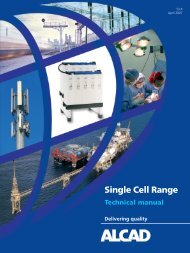Lead Acid Battery Operating Instructions - Alcad.com
Lead Acid Battery Operating Instructions - Alcad.com
Lead Acid Battery Operating Instructions - Alcad.com
You also want an ePaper? Increase the reach of your titles
YUMPU automatically turns print PDFs into web optimized ePapers that Google loves.
6 Installation<br />
Make sure that all cell jars and covers are thoroughly clean and dry.<br />
Clean the flat contact-making surfaces of the terminal posts with a soft clean<br />
rag. If there is evidence of acid having been spilled, the whole length of the<br />
posts should be wiped down with a rag which has been dipped into a non-<br />
caustic alkali solution, preferably dilute ammonia or baking soda. This will<br />
neutralize any acid on these parts. Do not allow any of this solution to get into<br />
the cells. Wipe the posts dry.<br />
Lightly abrade the contact surfaces of the terminal posts, using a Scotchbrite<br />
pad or fine grit abrasive paper, to remove any surface oxidation. Wipe off any<br />
loose particles and cover the whole length of the post down to the cover with<br />
a thin coating of "No-Ox-ld " grease.<br />
Batteries with cells or blocks weighing 75 Ibs. or more are supplied with a<br />
lifting strap and spreader plate. Separate instructions for the use of these<br />
items are supplied with each lifting kit.<br />
Warning<br />
NEVER LIFT CELLS BY THE TERMINAL POSTS<br />
Always use lifting straps, when provided, together with suitable mechanical<br />
lifting devices, to prevent injury to personnel or damage to the cells.<br />
Place the cells or blocks in position on the rack at the correct spacing which<br />
will ac<strong>com</strong>modate the intercell connectors supplied. Most batteries have cells<br />
connected in a simple series arrangement, so the cells should be arranged to<br />
preserve the sequence: positive, negative, positive, negative throughout the<br />
whole battery.<br />
For batteries on tiered racks, start by placing cells or blocks at the center of<br />
the lower tier. For batteries on stepped racks. place the first cells at the<br />
center of the rear most step.<br />
Any unused rack space should be left on the uppermost/rearmost tier/step.<br />
Where multiple racks are arranged end-to-end, adjust the position of the<br />
adjacent end cells to ac<strong>com</strong>modate the flexible inter-rack connectors<br />
supplied.<br />
Prepare the intercell connectors by lightly abrading the contact surfaces with<br />
a Scotchbrite pad or fine grit abrasive paper. Do not use a wire brush and be<br />
especially careful not to break through the lead plating.<br />
Apply a light coating of "No-Ox-ld" grease to the contact-making areas of<br />
each connector. This is best done by carefully melting the grease and dipping<br />
connector ends (it is unnecessary to coat the central part of the connector).<br />
Fasten the intercell connectors in place using the bolts, nuts and washers<br />
supplied. Before assembly, lightly smear "No-Ox-Id" grease on the surfaces<br />
of all hardware. Use the insulated wrenches supplied to tighten the parts<br />
firmly together (see the table below<br />
for torque settings). Care must be taken to avoid short circuiting the cells with any of the<br />
battery<br />
hardware.<br />
-4-



